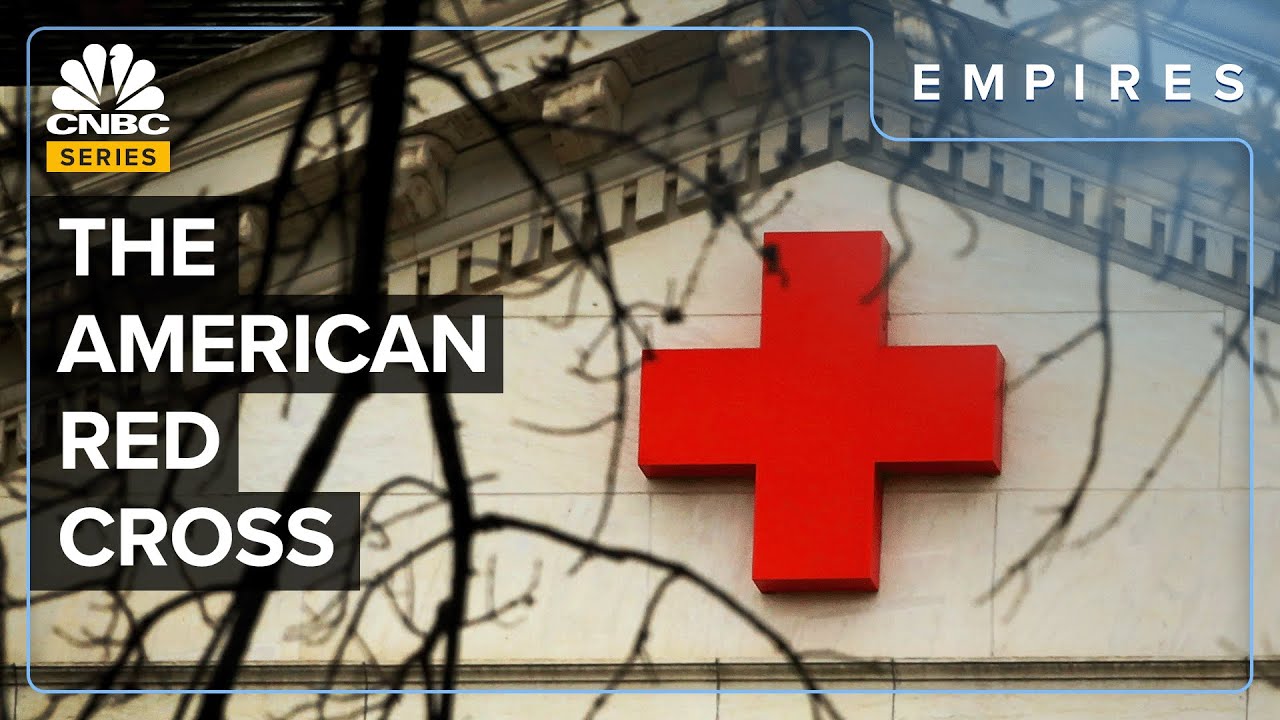The Red Cross has long
been recognized as a Universal symbol of
humanitarian services, and It's an enormous
operation. The American Red Cross has about 230
chapters nationwide, with Almost 18,000 employees
and more than a quarter of A million volunteers
responding to more than 60,000 disasters every
year. It's really the preeminent
organization in the wake Of domestic national
disasters like floods, Hurricanes, wildfires. In 2022, the American Red Cross had net assets of About $2.7 billion and
spent just over $3 billion In operating expenses the
same year. When you look at charities
in the United States, most Are quite small. $0 to $5 million is where
the vast majority of American nonprofits sit
today. So the American Red Cross
really is at a different Size and percentage than
just about everyone else. When the White House
starts raising money, when Big corporations, the
NFL, Hollywood A-listers, When they're raising
money in the aftermath of A disaster, it's most
likely targeted towards The American Red Cross. But the sheer size of
their budget has also Raised concerns over the
years. There is controversy
swirling around one of the Biggest charities of all,
the Red Cross. There are critics raising
questions about Transparency and about
how the money you give is Spent. They're the biggest
player, they're receiving The lion's share of the
funds. And so of course, The focus is going to be
on what they're doing with
That money. So how does the American
Red Cross make and spend Its billions? In 1863, The
International Red Cross Movement first began in
Geneva, Switzerland, to Help protect the sick and
wounded during combat. A nurse by the name of
Clara Barton later brought The idea to the U.S. In 1881, and established
the American Association Of the Red Cross. Today, it's one of the
few selected Congressionally chartered
non-profits in America, Frequently collaborating
with federal institutions Like FEMA and the U.S. Military. The American Red Cross is
a large and established And very well-funded
organization, and so it's Really able to have its
hand in a lot of different Programs. Their most well-known
efforts are arguably in Disaster relief. This can range from
responding to small house Fires to multi state
natural disasters such as Hurricanes, floods and
wildfires. One of the primary things
it does is that it Mobilizes volunteers to
provide boots on the Ground aid in the wake of
domestic national Disasters, and so it
helps to transport and Distribute aid to people
in emergency situations. And it can often do this
before some of the other Non-profits can come in
and do what they do best, Such as medical
professionals. But the organization's
biggest operation is Actually in blood supply.
The American Red Cross is
essentially responsible For about 40% of the
blood supply in the United States. It's central to
the supply chain for blood Transfusions. So it
collects and tests Volunteer blood
donations. And then it's Responsible for
distributing these blood Donations to about 2,500
facilities and hospitals Across the country. The American Red Cross
also performs other lesser Known services, such as
providing training and Certification, assistance
for military families, and International aid and
support. When you've been around
for over 100 years, you Start growing into the
areas that you really can Contribute, and the
American Red Cross has Clearly done that in a
very effective way. In 2022, the Red Cross
generated over $3.2 Billion in operating
revenue. A third of that, about $1
billion, comes from Contributions. These
include donations from Corporations and
individuals, contracts From the federal
government, as well as Donated materials and
services. It's really sort of the
charity of choice. When the White House
starts raising money, when Big corporations, the
NFL, Hollywood A-listers, When they're raising
money in the aftermath of A disaster, it's most
likely targeted towards The American Red Cross.
And that puts them in a Really unique position as
sort of the main recipient Of donations in this
immediate aftermath. The American Red Cross is
quite effective in their Fundraising, and we look
at the fundraising Efficiency and
essentially how many cents
On the dollar does it
cost you to raise a Dollar. And in 2022, it
costs them 17.8 cents to Raise $1. But the majority of their
revenue, just over $1.8 Billion, comes from what
their financial statements Refer to as biomedical
services. Predominantly funded by
programs oriented on the Sale of biomedical
products, which is really Their blood business. The American Red Cross
essentially collects blood From donors, and then as
part of the way it raises Revenue to recover costs,
it then sells that blood To about 2,500 hospitals
and medical facilities Across the country. When CNBC inquired about
the pricing of these Products, the American
Red Cross responded that Prices for a unit of red
blood cells is proprietary Information. The pricing
is determined by purchase Volumes by blood type,
service levels, and Delivery requirements, as
well as other agreed upon Terms with a hospital. The more transparent an
organization can be, the Greater the possibility,
I think, for trust to be Established between that
nonprofit and its donor Base. If it appears that
you're withholding Information or you're
being a little bit closed With some of your
practices, that can raise Concern. The American Red Cross
further clarified that it Does not charge for the
blood itself, but instead Is reimbursed by
hospitals and transfusion Centers for the costs
associated with providing Blood products. A majority of the
American Red Cross is
Operating expenses, just
over $2 million, are also Spent on collecting
blood. About $139 million More than the revenue
they make from biomedical Services. Drawing blood is actually
a medical intervention That requires certain
levels of certification by The people doing that
work. The preservation of That blood, sort of
keeping it refrigerated, Making sure that it
actually stays clean, gets Through all these places.
All of that costs money. I think one should take
comfort in the fact that They're trying to run a
sustainable business, so That they can also
provide aid and disaster Recovery, and then help
train us in the different Areas of, let's say, CPR
and first aid. The American Red Cross
revenue has always Surpassed its operating
expenses every year since 2020. That has allowed
the organization to build Up its net assets to
about $2.7 billion. Nonprofit organizations. They don't have a quote,
unquote profit per se. They do have increases
and decreases in their net Fund balance. And so what
that means is that, in Some years, an
organization might take in More money than it
spends, and another year It might spend more than
it takes in. They have to have money on
hand so that they can act Instantly. When a
hurricane hits or a fire Starts burning somewhere. You can't start looking
for money when you need People on the street
instantly, and you're Sending out ambulances
and trucks and whatever it Is that needs to happen
there. So generally, the
American Red Cross is not
Different than any other
working charity. When you have an excess,
you put it in reserves. When you need it, you
spend it. The Red Cross also claims
that it spends an average Of $0.90 for every dollar
it spends on those who are In need, based on their
financial statements for 2022, overhead expenses
like fundraising and Management accounted for
just 9.3% of total Expenses. This is a very large
organization, and when you Look at in a global way,
how does it spend? How efficiently does it
spend its resources? Overall, it's a highly
efficient organization. Nevertheless, the American
Red Cross has faced Numerous criticisms
regarding the utilization Of funds and its
effectiveness. A 2007 Government
Accountability Office Report said the Red Cross
lacked adequate plans for Providing shelter and
temporary housing to Victims of catastrophic
disasters such as Hurricanes Katrina and
Rita. After 9/11, government
officials criticized the Red Cross for diverting
relief funds to its General operating fund. Criticism surrounding the
American Red Cross's Response to the 2010
Haiti earthquake led Senator Chuck Grassley to
release a memo in 2016. His inquiry revealed that
a quarter of the raised Funds for relief were
spent on other expenses. The Red Cross immediately
disputed these claims, Arguing that 91% of the
$490 million collected was Invested in programs,
while just 9% was spent on Overall management,
general, and fundraisers. Experts suggest that
matters like these are
Often due to a lack of
transparency. You can look at Red Cross
annual reports, monthly Reports, updates from
their different disaster Response, and you see
these huge numbers. That's great. But what
does that actually mean? And it's not in their
interest to break that Down and explain what
that means. So in Haiti, the Red Cross was saying, we Provided 130,000 people
with new homes. Well, that's not true. The Red Cross built six
new homes in Haiti. What that number actually
is including are families That got rental
subsidies, people who got Training in construction
techniques right across The board. These things
don't necessarily actually Put a roof over anybody's
head. They're broadly involved
with the shelter sector. Senator Grassley
eventually introduced the American Red Cross
Transparency Act in 2016 And 2019, to allow for
more government oversight Over the organization. Previously, in 2015, Gao
published a public study Concluding that no
regular independent Evaluations are conducted
of the impact or Effectiveness of the Red Cross disaster services. I think not just the Red Cross could benefit from Greater government
oversight, but NGOs across The board. It's a sort of
Wild West out there. These groups bring in
hundreds of millions of Dollars and are spending
it all over the world, and There's very little
accountability for what They're spending it on,
how they're managing that Money. And so I think any
step that can lead Towards, first off,
greater transparency and
Second off, greater
accountability should be Welcomed by these
organizations. Experts suggest that such
a level of scrutiny is Inevitable for
organizations like the Red Cross. I think the American Red Cross comes under scrutiny Much more than other
organizations, primarily Because they tend to be
everywhere there's a Problem. They're highly
visible. And that visibility, plus
their size, plus the fact That we have a dependance
on them, we do hold them To a higher standard. But criticisms could help
Red Cross to grow even Further. It's really important for
people to understand we Are all stakeholders,
either as donors or as Taxpayers in the Red Cross, as well as other Charities. In terms of,
we do need to hold them Accountable for operating
efficiently and Effectively because we're
essentially, as taxpayers, Subsidizing this and
other charities' ability To exist. When it's well
placed criticism, that's Part of what helps a
nonprofit to evaluate how It's operating and to
improve and to get better. So, while it does receive
some criticism because of The huge volume of work
that it does across the Country, the best thing
it can do is to take that Criticism to heart and
kind of self-reflect and Find ways to improve its
transparency, to improve The way it operates, and
to mitigate any sort of Fraud or mismanagement or
theft that does go on During natural disasters. There's all kinds of ways
to improve.





